Ecological Security Pattern Construction and Multi-Scenario Risk Early Warning (2020–2035) in the Guangdong–Hong Kong–Macao Greater Bay Area, China
Abstract
1. Introduction
2. Materials and Methods
2.1. Study Area
2.2. Data Sources and Processing
2.3. Delineation of Ecological Security Risk Zones
2.3.1. Habitat Quality Assessment
2.3.2. Landscape Ecological Risk Model
2.4. Identifying Ecological Security Patterns
2.4.1. Identify Ecological Sources
- (1)
- Ecosystem service value assessment
- (2)
- Ecosystem sensitivity assessment
- (3)
- Landscape connectivity evaluation
2.4.2. Resistance Surface Construction
2.4.3. Corridors and Pinch Points Extraction
2.5. Multi-Scenario Risk Early Warning of Ecological Security Patterns
- (1)
- The NDS analyzes the land use change trend in the study area from 2000 to 2020 using the Markov model, without considering various macro-policy regulation requirements, to predict the future demand for each land type.
- (2)
- The EPS considers the environmental carrying capacity and ensures ecological benefits, building on the natural development scenario. Specific settings: grassland and forestland to built-up land is reduced by 30%, arable land and waters to built-up land by 20%, and built-up land to forestland is increased by 10%.
- (3)
- The EDS prioritizes economic benefits, aiming to boost economic output and urbanization rates, based on the natural development scenario. Specific settings: arable land, forestland, and grassland to built-up land increase by 20%, while built-up land to non-arable landscape types decreases by 30%.
3. Results
3.1. Results of Ecological Security Risk Zones Division
3.2. Ecological Security Patterns
3.2.1. Ecological Source and Resistance Surface
3.2.2. Ecological Security Patterns
3.2.3. Multi-Level Ecological Security Patterns
3.3. Early Warning of Ecological Security Pattern Risk
- (1)
- Under the NDS, the warning level is between the EPS and EDS. The ecological source warning level is relatively good, and the number of severe and extreme warnings is at a low level. The number of severe and extreme warnings in ecological corridors is relatively large, mainly distributed in the center of the study area, connecting all parts of the area. The situation of ecological sources is slightly serious and needs to be addressed. In pinch points, there are many severe warnings, mainly in ecological corridors on both sides of the Pearl River Estuary.
- (2)
- Under the EPS, the regional ecological security situation is obviously optimized. All ecological sources are in a state of no warning, which is conducive to ensuring regional ecological security. Most ecological corridors are kept in a state of no warning or mild warning to ensure the connectivity of regional landscape. There is no moderate warning alarm or above for pinch points, which can ensure the stability of key nodes. It shows that under the policy guidance of ecological priority, ESP is well maintained, and biodiversity and ecosystem service functions are maintained at a healthy level.
- (3)
- Under the EDS, the ecological pressure faced by the study area suddenly increases, and the total area of regional early warning is as high as 358.17 km2. The total number of severe and extreme warnings in ecological sources, corridors, and pinch points is as high as 101, seven times that of NDS. Among them, pinch points are in an all-round alert state, and the migration and diffusion of ecological flow will be hindered. This indicates that under the influence of rapid economic growth, if appropriate ecological protection measures are not taken, the integrity of regional ecological sources and ecological networks will be seriously threatened.
4. Discussion
4.1. Feasibility Analysis of Risk Early Warning Methods for Ecological Security Patterns
4.2. Implications of Ecological Security Pattern Risk Assessment and Multi-Scenario Risk Early Warning
4.3. Limitations and Future Research Prospects
5. Conclusions
Author Contributions
Funding
Data Availability Statement
Conflicts of Interest
References
- Lu, X.; Shi, Z.; Li, J.; Dong, J.; Song, M.; Hou, J. Research on the Impact of Factor Flow on Urban Land Use Efficiency from the Perspective of Urbanization. Land 2022, 11, 389. [Google Scholar] [CrossRef]
- Yang, L.; Li, Y.; Jia, L.; Ji, Y.; Hu, G. Ecological Risk Assessment and Ecological Security Pattern Optimization in the Middle Reaches of the Yellow River Based on ERI+MCR Model. J. Geogr. Sci. 2023, 33, 823–844. [Google Scholar] [CrossRef]
- Jia, Q.; Jiao, L.; Lian, X.; Wang, W. Linking Supply-Demand Balance of Ecosystem Services to Identify Ecological Security Patterns in Urban Agglomerations. Sustain. Cities Soc. 2023, 92, 104497. [Google Scholar] [CrossRef]
- Jiao, Z.; Wu, Z.; Wei, B.; Luo, Y.; Lin, Y.; Xue, Y.; Li, S.; Gao, F. Introducing Big Data to Measure the Spatial Heterogeneity of Human Activities for Optimizing the Ecological Security Pattern: A Case Study from Guangzhou City, China. Ecol. Indic. 2023, 150, 110203. [Google Scholar] [CrossRef]
- Wu, W.; Zhao, S.; Guo, J.; Ou, M.; Ding, G. Construction and Optimization of Ecological Security Pattern Based on the Circuit Theory: A Case Study of Hohhot City. Environ. Sci. Pollut. Res. 2023, 30, 89597–89615. [Google Scholar] [CrossRef] [PubMed]
- Yang, Q.; He, C.; Xu, Y.; Ye, Y.; Guo, H.; Zhang, S.; Li, F.; Liu, K. Coastal Wetlands Play an Important Role in the Ecological Security Pattern of the Coastal Zone. Land 2022, 11, 2317. [Google Scholar] [CrossRef]
- Chen, J.; Mei, Z.; Wang, B.; Wei, J. Construction of Ecological Security Patterns Based on Circuit Theory under the Resistance Distance Principle. Int. J. Environ. Res. Public Health 2022, 19, 6298. [Google Scholar] [CrossRef] [PubMed]
- Hui, L.; Na, Y.; Wen, Y.; Si, W.; Zhi, L.; Shu, Y. Shangri-La county ecological land use planning based on landscape security pattern. Acta Ecol. Sin. 2011, 31, 5928–5936. (In Chinese) [Google Scholar]
- Zhang, L.; Peng, J.; Liu, Y.; Wu, J. Coupling Ecosystem Services Supply and Human Ecological Demand to Identify Landscape Ecological Security Pattern: A Case Study in Beijing–Tianjin–Hebei Region, China. Urban Ecosyst. 2017, 20, 701–714. [Google Scholar] [CrossRef]
- Hu, C.; Wang, Z.; Huang, G.; Ding, Y. Construction, Evaluation, and Optimization of a Regional Ecological Security Pattern Based on MSPA–Circuit Theory Approach. Int. J. Environ. Res. Public Health 2022, 19, 16184. [Google Scholar] [CrossRef]
- Chen, J.; Wang, S.; Zou, Y. Construction of an Ecological Security Pattern Based on Ecosystem Sensitivity and the Importance of Ecological Services: A Case Study of the Guanzhong Plain Urban Agglomeration, China. Ecol. Indic. 2022, 136, 108688. [Google Scholar] [CrossRef]
- Zhang, Y.; Zhao, Z.; Fu, B.; Ma, R.; Yang, Y.; Lü, Y.; Wu, X. Identifying Ecological Security Patterns Based on the Supply, Demand and Sensitivity of Ecosystem Service: A Case Study in the Yellow River Basin, China. J. Environ. Manag. 2022, 315, 115158. [Google Scholar] [CrossRef]
- Gao, Y.; Ma, L.; Liu, J.; Zhuang, Z.; Huang, Q.; Li, M. Constructing Ecological Networks Based on Habitat Quality Assessment: A Case Study of Changzhou, China. Sci. Rep. 2017, 7, 46073. [Google Scholar] [CrossRef]
- Ding, M.; Liu, W.; Xiao, L.; Zhong, F.; Lu, N.; Zhang, J.; Zhang, Z.; Xu, X.; Wang, K. Construction and Optimization Strategy of Ecological Security Pattern in a Rapidly Urbanizing Region: A Case Study in Central-South China. Ecol. Indic. 2022, 136, 108604. [Google Scholar] [CrossRef]
- Huang, L.; He, C.; Wang, B. Study on the Spatial Changes Concerning Ecosystem Services Value in Lhasa River Basin, China. Environ. Sci. Pollut. Res. 2022, 29, 7827–7843. [Google Scholar] [CrossRef] [PubMed]
- Luo, M.; Jia, X.; Zhao, Y.; Wang, H.; Chen, C.; Li, D.; Yang, S.; Li, J. The Temporal and Spatial Characteristics of Ecological Security Pattern in the Loess Plateau, China. Land 2024, 13, 570. [Google Scholar] [CrossRef]
- Huang, M.; Gong, D.; Zhang, L.; Lin, H.; Chen, Y.; Zhu, D.; Xiao, C.; Altan, O. Spatiotemporal Dynamics and Forecasting of Ecological Security Pattern under the Consideration of Protecting Habitat: A Case Study of the Poyang Lake Ecoregion. Int. J. Digit. Earth 2024, 17, 2376277. [Google Scholar] [CrossRef]
- Dickson, B.G.; Albano, C.M.; Anantharaman, R.; Beier, P.; Fargione, J.; Graves, T.A.; Gray, M.E.; Hall, K.R.; Lawler, J.J.; Leonard, P.B.; et al. Circuit-theory Applications to Connectivity Science and Conservation. Conserv. Biol. 2019, 33, 239–249. [Google Scholar] [CrossRef]
- Wu, Y.; Han, Z.; Meng, J.; Zhu, L. Circuit Theory-Based Ecological Security Pattern Could Promote Ecological Protection in the Heihe River Basin of China. Environ. Sci. Pollut. Res. 2022, 30, 27340–27356. [Google Scholar] [CrossRef]
- Huang, X.; Wang, H.; Shan, L.; Xiao, F. Constructing and Optimizing Urban Ecological Network in the Context of Rapid Urbanization for Improving Landscape Connectivity. Ecol. Indic. 2021, 132, 108319. [Google Scholar] [CrossRef]
- Li, Q.; Zhou, Y.; Yi, S. An Integrated Approach to Constructing Ecological Security Patterns and Identifying Ecological Restoration and Protection Areas: A Case Study of Jingmen, China. Ecol. Indic. 2022, 137, 108723. [Google Scholar] [CrossRef]
- Jiao, M.; Wang, Y.; Hu, M.; Xia, B. Spatial Deconstruction and Differentiation Analysis of Early Warning for Ecological Security in the Pearl River Delta, China. Sustain. Cities Soc. 2021, 64, 102557. [Google Scholar] [CrossRef]
- Xiao, P.; Zhou, Y.; Li, M.; Xu, J. Spatiotemporal Patterns of Habitat Quality and Its Topographic Gradient Effects of Hubei Province Based on the InVEST Model. Environ. Dev. Sustain. 2023, 25, 6419–6448. [Google Scholar] [CrossRef]
- Ai, J.; Yu, K.; Zeng, Z.; Yang, L.; Liu, Y.; Liu, J. Assessing the Dynamic Landscape Ecological Risk and Its Driving Forces in an Island City Based on Optimal Spatial Scales: Haitan Island, China. Ecol. Indic. 2022, 137, 108771. [Google Scholar] [CrossRef]
- Wu, L.; Fan, F. Assessment of Ecosystem Services in New Perspective: A Comprehensive Ecosystem Service Index (CESI) as a Proxy to Integrate Multiple Ecosystem Services. Ecol. Indic. 2022, 138, 108800. [Google Scholar] [CrossRef]
- Tang, H.; Peng, J.; Jiang, H.; Lin, Y.; Dong, J.; Liu, M.; Meersmans, J. Spatial Analysis Enables Priority Selection in Conservation Practices for Landscapes That Need Ecological Security. J. Environ. Manag. 2023, 345, 118888. [Google Scholar] [CrossRef] [PubMed]
- Zeng, W.; Tang, H.; Liang, X.; Hu, Z.; Yang, Z.; Guan, Q. Using Ecological Security Pattern to Identify Priority Protected Areas: A Case Study in the Wuhan Metropolitan Area, China. Ecol. Indic. 2023, 148, 110121. [Google Scholar] [CrossRef]
- Yang, L.; Jin, L.; Xiang, S. An early warning method on ecological risk and its application to improve landscape ecological security pattern regulation. Geogr. Res. 2017, 36, 485–494. (In Chinese) [Google Scholar]
- Chao, Y.; Chen, W.; Zhe, F.; Ke, W.; Hua, Z. Urgency Classification of Beijing Ecological Security Pattern Protection. Beijing Da Xue Xue Bao 2020, 56, 1047–1055. (In Chinese) [Google Scholar]
- Wang, S.; Song, Q.; Zhao, J.; Lu, Z.; Zhang, H. Identification of Key Areas and Early-Warning Points for Ecological Protection and Restoration in the Yellow River Source Area Based on Ecological Security Pattern. Land 2023, 12, 1643. [Google Scholar] [CrossRef]
- Jian, L.; Shen, L.; Shen, F.; Yong, H. Identification of territorial ecological protection and restoration areas and early warning places based on ecological security pattern: A case study in Xiamen-Zhangzhou-Quanzhou Region. Acta Ecol. Sin. 2021, 41, 8124–8134. (In Chinese) [Google Scholar]
- Guo, H.; Cai, Y.; Li, B.; Tang, Y.; Qi, Z.; Huang, Y.; Yang, Z. An Integrated Modeling Approach for Ecological Risks Assessment under Multiple Scenarios in Guangzhou, China. Ecol. Indic. 2022, 142, 109270. [Google Scholar] [CrossRef]
- Ji, X.; Wu, D.; Yan, Y.; Guo, W.; Li, K. Interpreting Regional Ecological Security from Perspective of Ecological Networks: A Case Study in Ningxia Hui Autonomous Region, China. Environ. Sci. Pollut. Res. 2023, 30, 65412–65426. [Google Scholar] [CrossRef] [PubMed]
- Liu, X.; Liang, X.; Li, X.; Xu, X.; Ou, J.; Chen, Y.; Li, S.; Wang, S.; Pei, F. A Future Land Use Simulation Model (FLUS) for Simulating Multiple Land Use Scenarios by Coupling Human and Natural Effects. Landsc. Urban Plan. 2017, 168, 94–116. [Google Scholar] [CrossRef]
- Zheng, F.; Hu, Y. Assessing Temporal-Spatial Land Use Simulation Effects with CLUE-S and Markov-CA Models in Beijing. Environ. Sci. Pollut. Res. 2018, 25, 32231–32245. [Google Scholar] [CrossRef] [PubMed]
- Fu, F.; Deng, S.; Wu, D.; Liu, W.; Bai, Z. Research on the Spatiotemporal Evolution of Land Use Landscape Pattern in a County Area Based on CA-Markov Model. Sustain. Cities Soc. 2022, 80, 103760. [Google Scholar] [CrossRef]
- Li, X.; Liu, Z.; Li, S.; Li, Y. Multi-Scenario Simulation Analysis of Land Use Impacts on Habitat Quality in Tianjin Based on the PLUS Model Coupled with the InVEST Model. Sustainability 2022, 14, 6923. [Google Scholar] [CrossRef]
- Duan, X.; Chen, Y.; Wang, L.; Zheng, G.; Liang, T. The Impact of Land Use and Land Cover Changes on the Landscape Pattern and Ecosystem Service Value in Sanjiangyuan Region of the Qinghai-Tibet Plateau. J. Environ. Manag. 2023, 325, 116539. [Google Scholar] [CrossRef] [PubMed]
- Wang, Q.; Guan, Q.; Sun, Y.; Du, Q.; Xiao, X.; Luo, H.; Zhang, J.; Mi, J. Simulation of Future Land Use/Cover Change (LUCC) in Typical Watersheds of Arid Regions under Multiple Scenarios. J. Environ. Manag. 2023, 335, 117543. [Google Scholar] [CrossRef]
- Peng, J.; Pan, Y.; Liu, Y.; Zhao, H.; Wang, Y. Linking Ecological Degradation Risk to Identify Ecological Security Patterns in a Rapidly Urbanizing Landscape. Habitat Int. 2018, 71, 110–124. [Google Scholar] [CrossRef]
- Sun, H.; Liu, C.; Wei, J. Identifying Key Sites of Green Infrastructure to Support Ecological Restoration in the Urban Agglomeration. Land 2021, 10, 1196. [Google Scholar] [CrossRef]
- Jiang, H.; Peng, J.; Dong, J.; Zhang, Z.; Xu, Z.; Meersmans, J. Linking Ecological Background and Demand to Identify Ecological Security Patterns across the Guangdong-Hong Kong-Macao Greater Bay Area in China. Landsc. Ecol. 2021, 36, 2135–2150. [Google Scholar] [CrossRef]
- Zhou, Y.; Zheng, Z.; Wu, Z.; Guo, C.; Chen, Y. Construction and Evaluation of Ecological Networks in Highly Urbanised Regions: A Case Study of the Guangdong-Hong Kong-Macao Greater Bay Area, China. Ecol. Indic. 2023, 152, 110336. [Google Scholar] [CrossRef]
- Wang, X.; Wen, Y.; Liu, X.; Wen, D.; Long, Y.; Zhao, P.; Liu, P.; Zhong, J. Protection Effect and Vacancy of the Ecological Protection Redline: A Case Study in Guangdong–Hong Kong–Macao Greater Bay Area, China. Remote Sens. 2021, 13, 5171. [Google Scholar] [CrossRef]
- Tang, F.; Wang, L.; Guo, Y.; Fu, M.; Huang, N.; Duan, W.; Luo, M.; Zhang, J.; Li, W.; Song, W. Spatio-Temporal Variation and Coupling Coordination Relationship between Urbanisation and Habitat Quality in the Grand Canal, China. Land Use Policy 2022, 117, 106119. [Google Scholar] [CrossRef]
- Ouyang, X.; Tang, L.; Wei, X.; Li, Y. Spatial Interaction between Urbanization and Ecosystem Services in Chinese Urban Agglomerations. Land Use Policy 2021, 109, 105587. [Google Scholar] [CrossRef]
- Sharp, R.; Chaplin-Krame, R.; Wood, S.; Guerry, A.; Tallis, H.; Ricketts, T. InVEST 3.2.0 User’s Guide; NatCap: Stanford, CA, USA, 2015. [Google Scholar]
- Li, M.; Zhou, Y.; Xiao, P.; Tian, Y.; Huang, H.; Xiao, L. Evolution of Habitat Quality and Its Topographic Gradient Effect in Northwest Hubei Province from 2000 to 2020 Based on the InVEST Model. Land 2021, 10, 857. [Google Scholar] [CrossRef]
- Wang, H.; Liu, X.; Zhao, C.; Chang, Y.; Liu, Y.; Zang, F. Spatial-Temporal Pattern Analysis of Landscape Ecological Risk Assessment Based on Land Use/Land Cover Change in Baishuijiang National Nature Reserve in Gansu Province, China. Ecol. Indic. 2021, 124, 107454. [Google Scholar] [CrossRef]
- Xu, W.; Wang, J.; Zhang, M.; Li, S. Construction of Landscape Ecological Network Based on Landscape Ecological Risk Assessment in a Large-Scale Opencast Coal Mine Area. J. Clean. Prod. 2021, 286, 125523. [Google Scholar] [CrossRef]
- Li, C.; Zhang, J.; Philbin, S.P.; Yang, X.; Dong, Z.; Hong, J.; Ballesteros-Pérez, P. Evaluating the Impact of Highway Construction Projects on Landscape Ecological Risks in High Altitude Plateaus. Sci. Rep. 2022, 12, 5170. [Google Scholar] [CrossRef]
- Zeng, C.; He, J.; He, Q.; Mao, Y.; Yu, B. Assessment of Land Use Pattern and Landscape Ecological Risk in the Chengdu-Chongqing Economic Circle, Southwestern China. Land 2022, 11, 659. [Google Scholar] [CrossRef]
- Cai, G.; Xiong, J.; Wen, L.; Weng, A.; Lin, Y.; Li, B. Predicting the Ecosystem Service Values and Constructing Ecological Security Patterns in Future Changing Land Use Patterns. Ecol. Indic. 2023, 154, 110787. [Google Scholar] [CrossRef]
- Wen, M.; Zhang, T.; Li, L.; Chen, L.; Hu, S.; Wang, J.; Liu, W.; Zhang, Y.; Yuan, L. Assessment of Land Ecological Security and Analysis of Influencing Factors in Chaohu Lake Basin, China from 1998–2018. Sustainability 2021, 13, 358. [Google Scholar] [CrossRef]
- Wang, X.; Wu, J.; Liu, Y.; Hai, X.; Shanguan, Z.; Deng, L. Driving Factors of Ecosystem Services and Their Spatiotemporal Change Assessment Based on Land Use Types in the Loess Plateau. J. Environ. Manag. 2022, 311, 114835. [Google Scholar] [CrossRef] [PubMed]
- Wang, F.; Yu, Q.; Qiu, S.; Xu, C.; Ma, J.; Liu, H. Study on the Relationship between Topological Characteristics of Ecological Spatial Network and Soil Conservation Function in Southeastern Tibet, China. Ecol. Indic. 2023, 146, 109791. [Google Scholar] [CrossRef]
- Bi, Y.; Zheng, L.; Wang, Y.; Li, J.; Yang, H.; Zhang, B. Coupling Relationship between Urbanization and Water-Related Ecosystem Services in China’s Yangtze River Economic Belt and Its Socio-Ecological Driving Forces: A County-Level Perspective. Ecol. Indic. 2023, 146, 109871. [Google Scholar] [CrossRef]
- Chen, Z.; Lin, J.; Huang, J. Linking Ecosystem Service Flow to Water-Related Ecological Security Pattern: A Methodological Approach Applied to a Coastal Province of China. J. Environ. Manag. 2023, 345, 118725. [Google Scholar] [CrossRef] [PubMed]
- Wang, Z.; Li, X.; Mao, Y.; Li, L.; Wang, X.; Lin, Q. Dynamic Simulation of Land Use Change and Assessment of Carbon Storage Based on Climate Change Scenarios at the City Level: A Case Study of Bortala, China. Ecol. Indic. 2022, 134, 108499. [Google Scholar] [CrossRef]
- Tsou, J.; Gao, Y.; Zhang, Y.; Genyun, S.; Ren, J.; Li, Y. Evaluating Urban Land Carrying Capacity Based on the Ecological Sensitivity Analysis: A Case Study in Hangzhou, China. Remote Sens. 2017, 9, 529. [Google Scholar] [CrossRef]
- Huang, J.; Hu, Y.; Zheng, F. Research on Recognition and Protection of Ecological Security Patterns Based on Circuit Theory: A Case Study of Jinan City. Environ. Sci. Pollut. Res. 2020, 27, 12414–12427. [Google Scholar] [CrossRef]
- Mcrae, B.H. Isolation by resistance. Evolution 2006, 60, 1551–1561. [Google Scholar] [PubMed]
- Mcrae, B.H.; Beier, P. Circuit theory predicts gene flow in plant and animal populations. Proc. Natl. Acad. Sci. USA 2007, 104, 19885–19890. [Google Scholar] [CrossRef] [PubMed]
- McRae, B.H.; Dickson, B.G.; Keitt, T.H.; Shah, V.B. Using circuit theory to model connectivity in ecology, evolution, and conservation. Ecology 2008, 89, 2712–2724. [Google Scholar] [CrossRef] [PubMed]
- Liang, X.; Guan, Q.; Clarke, K.C.; Liu, S.; Wang, B.; Yao, Y. Understanding the Drivers of Sustainable Land Expansion Using a Patch-Generating Land Use Simulation (PLUS) Model: A Case Study in Wuhan, China. Comput. Environ. Urban Syst. 2021, 85, 101569. [Google Scholar] [CrossRef]
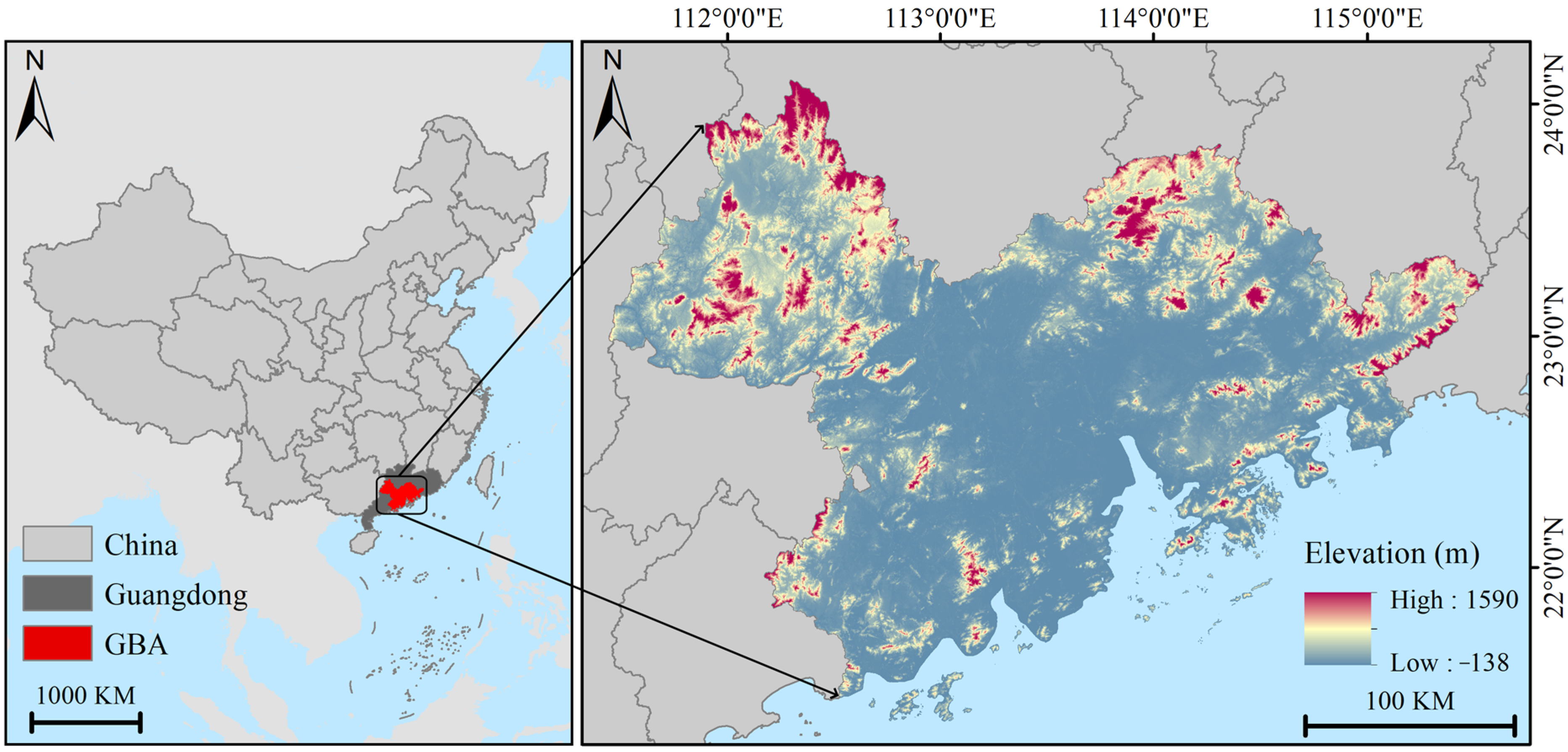
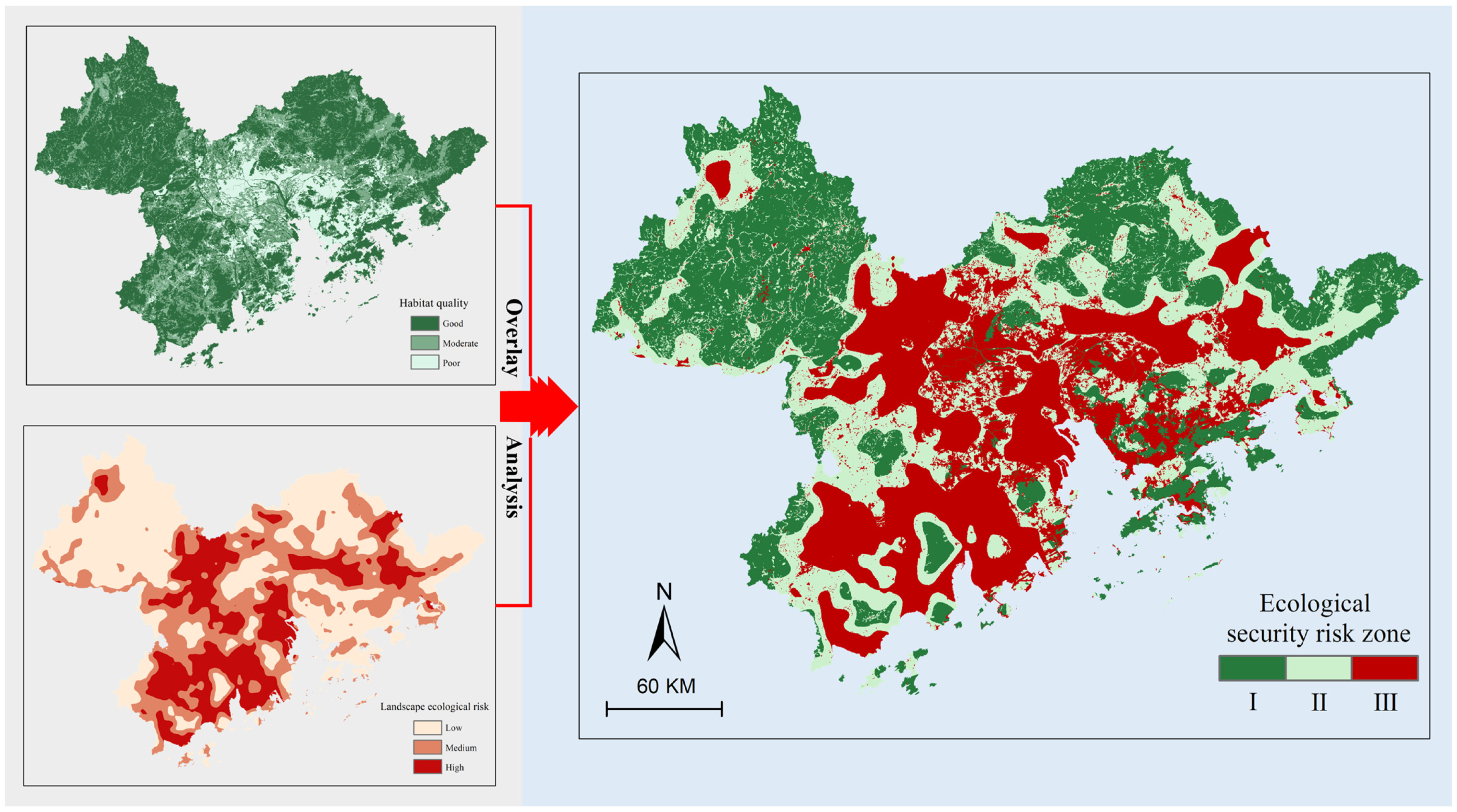
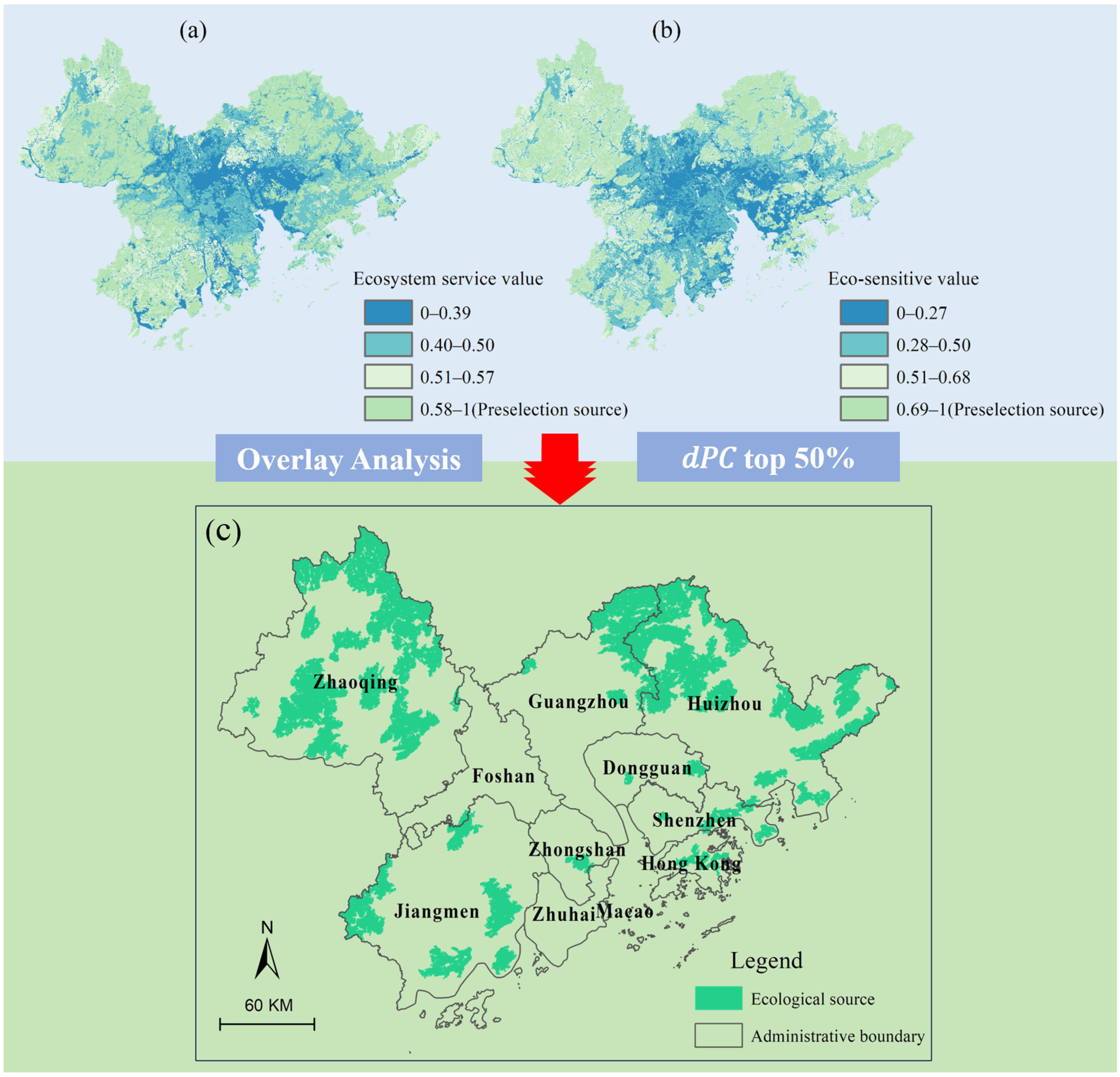
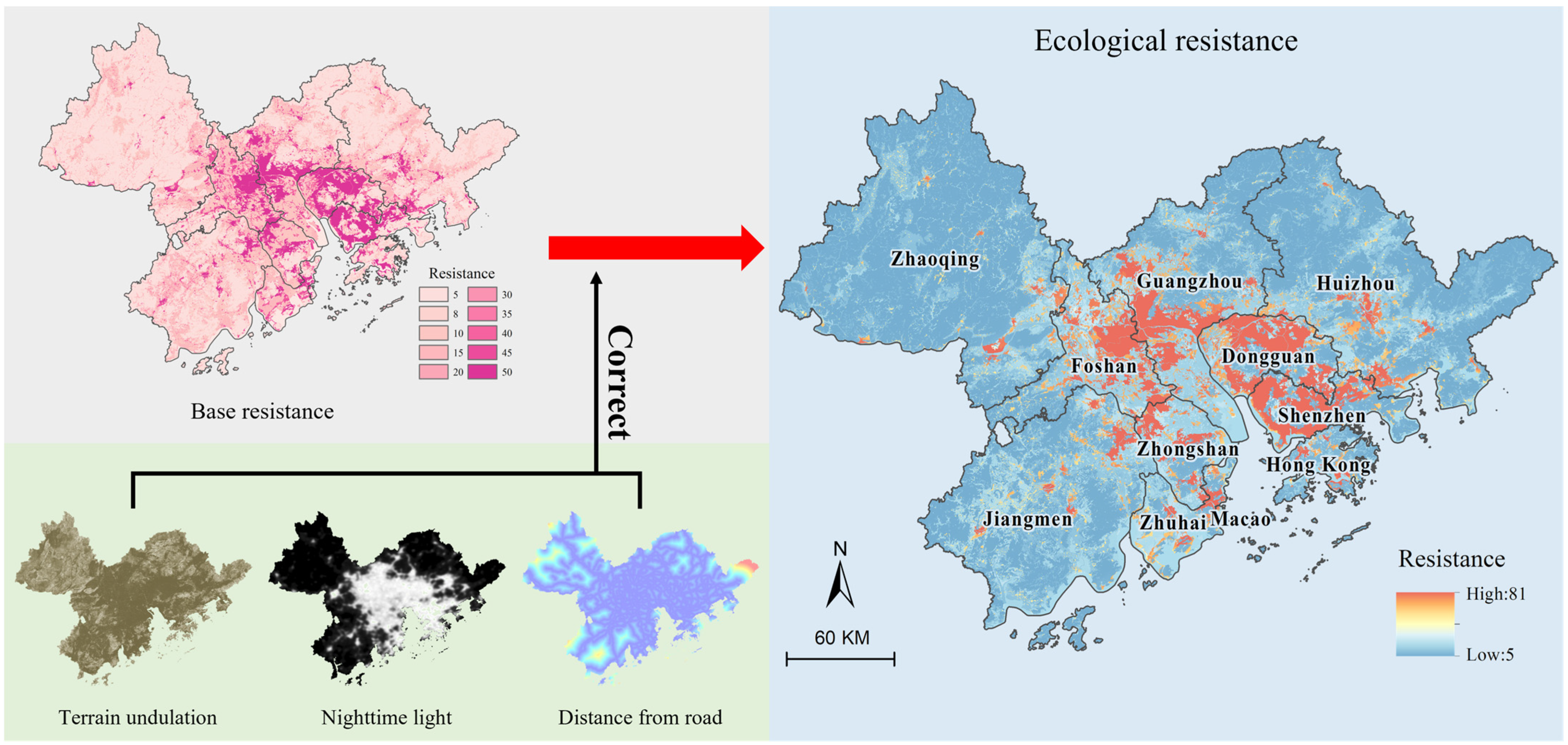
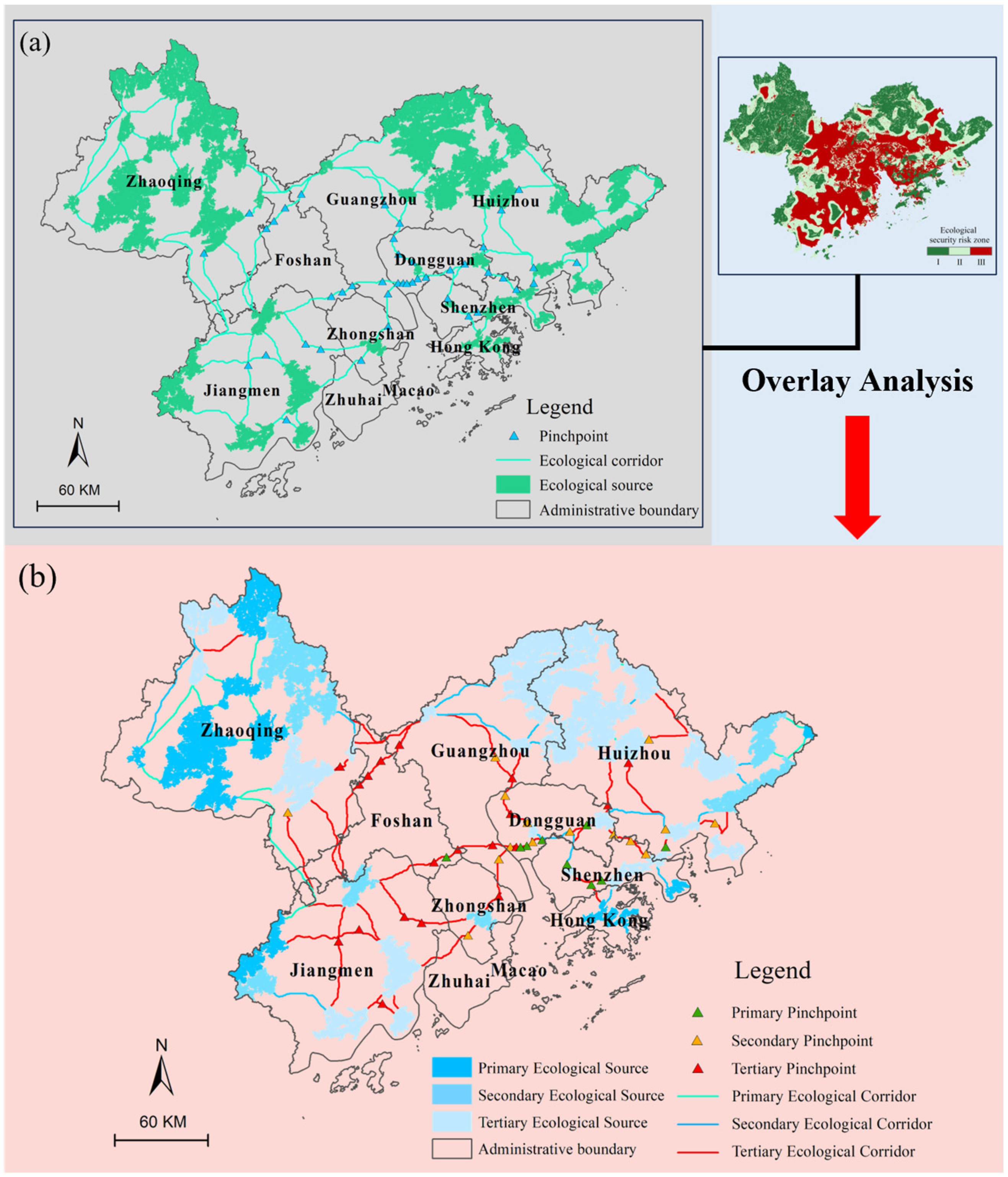



| Data Category | Data Name | Time | Resolution | Data Source |
|---|---|---|---|---|
| Land use | Land use data of GHKMGBA | 2000, 2010, 2020 | 30 m | National Ecological Science Data Center https://www.resdc.cn (accessed on 3 May 2023) |
| Meteorological data | Annual average temperature | 2020 | 1 km | |
| Annual average precipitation | 2020 | 1 km | ||
| Socioeconomic data | Population density | 2019 | 1 km | |
| GDP | 2020 | 1 km | ||
| Nighttime light | 2020 | 1 km | ||
| Road | 2020 | - | OpenStreetMap https://www.openstreetmap.org (accessed on 3 May 2023) | |
| Natural environment data | River | 2020 | - | |
| Potential evapotranspiration | 2020 | 1 km | National Tibetan Plateau https://data.tpdc.ac.cn (accessed on 3 May 2023) | |
| Vegetation cover | 2020 | 250 m | ||
| Soil data | 2013 | 1 km | Harmonized World Soil Database from FAO (https://www.fao.org/) (accessed on 23 May 2024) | |
| DEM | 2020 | 30 m | Geospatial Data Cloud (www.gscloud.cn) (accessed on 3 May 2023) | |
| Slope/relief degree of land surface data | 2020 | 30 m | Based on DEM calculation |
| Habitat Quality Level | Landscape Ecological Risk Level | ||
|---|---|---|---|
| Low | Medium | High | |
| Poor | III | III | III |
| Moderate | II | II | III |
| Good | I | II | III |
| Ecosytem Service Index | Calculation Formula | Explanation | Reference |
|---|---|---|---|
| Soil conservation | SC represents the soil conservation capacity of unit i, R is the rainfall erosivity factor, K is the soil erodibility factor, LS is the topographic factor, C is the vegetation coverage factor, and P is the factor of soil and water conservation measures. Among them, the K factor is calculated based on the world soil database, R is calculated based on the annual rainfall data, LS is calculated based on DEM, and C and P are set according to the existing related research. | [7,56,57] | |
| Water yield | WY(x) represents the annual water supply of unit x, AET(x) is the annual actual evapotranspiration of unit x, PET(x) is the annual potential evapotranspiration of unit x, and PRE(x) is the annual precipitation of unit x. | [58] | |
| Carbon sequestration | Ci is the total carbon storage of type i, Ci-above and Ci-below are the aboveground and underground carbon densities of type i, Ci-soil is the soil organic carbon density of type i, Ci-dead is the dead organic carbon density of type i, Ctotal is the regional total carbon storage, and Si is the area of type i. Concerning A dataset of carbon density in Chinese terrestrial ecosystems (2010s) and related research is used. | [25,59] |
| Land Use Class I | Land Use Class II | Resistance Value |
|---|---|---|
| Arable land | paddy field | 10 |
| Dryland | 15 | |
| Forestland | Shrubland | 10 |
| Forestland | 5 | |
| Other forestland | 8 | |
| Grassland | High-cover grassland | 10 |
| Medium-cover grassland | 8 | |
| Low-cover grassland | 5 | |
| Water area | Canals | 10 |
| Rivers | 20 | |
| Reservoirs | 15 | |
| Mudflats | 20 | |
| Built-up land | Urban built-up land | 50 |
| Rural built-up land | 40 | |
| Other built-up land | 45 | |
| Unused land | sandy land | 30 |
| marshland | 35 | |
| bare ground | 20 | |
| Other unused land | 15 |
| Buffer Zone Level | |||
|---|---|---|---|
| Buffer Type | I | II | III |
| Ecological corridor buffer zone | 1 km | 2 km | 3 km |
| Pinch point buffer zone | 3 km | 4 km | 5 km |
| Area of Encroachment on Ecological Sources (km2) | Area of Encroachment on Ecological Corridor Buffer Zones (km2) | Area of Encroachment on the Buffer Zone of Pinch Points (km2) | Warning Level | Warning Situation |
|---|---|---|---|---|
| 0 ≤ area < 0.21 | 0 ≤ area < 0.09 | 0 ≤ area < 0.05 | V | No warning |
| 0.21 ≤ area < 0.66 | 0.09 ≤ area < 0.78 | 0.05 ≤ area < 1.15 | IV | Light warning |
| 0.66 ≤ area < 1.71 | 0.78 ≤ area < 4.27 | 1.15 ≤ area < 3.51 | III | Medium warning |
| 1.71 ≤ area < 5.76 | 4.27 ≤ area < 14.81 | 3.51 ≤ area < 5.6 | II | Severe warning |
| 5.76 ≤ area < 61.73 | 14.81 ≤ area < 110.61 | 5.6 ≤ area < 17.36 | I | Extreme Warning |
Disclaimer/Publisher’s Note: The statements, opinions and data contained in all publications are solely those of the individual author(s) and contributor(s) and not of MDPI and/or the editor(s). MDPI and/or the editor(s) disclaim responsibility for any injury to people or property resulting from any ideas, methods, instructions or products referred to in the content. |
© 2024 by the authors. Licensee MDPI, Basel, Switzerland. This article is an open access article distributed under the terms and conditions of the Creative Commons Attribution (CC BY) license (https://creativecommons.org/licenses/by/4.0/).
Share and Cite
Ma, J.; Mei, Z.; Wang, X.; Li, S.; Liang, J. Ecological Security Pattern Construction and Multi-Scenario Risk Early Warning (2020–2035) in the Guangdong–Hong Kong–Macao Greater Bay Area, China. Land 2024, 13, 1267. https://doi.org/10.3390/land13081267
Ma J, Mei Z, Wang X, Li S, Liang J. Ecological Security Pattern Construction and Multi-Scenario Risk Early Warning (2020–2035) in the Guangdong–Hong Kong–Macao Greater Bay Area, China. Land. 2024; 13(8):1267. https://doi.org/10.3390/land13081267
Chicago/Turabian StyleMa, Junjie, Zhixiong Mei, Xinyu Wang, Sichen Li, and Jiangsen Liang. 2024. "Ecological Security Pattern Construction and Multi-Scenario Risk Early Warning (2020–2035) in the Guangdong–Hong Kong–Macao Greater Bay Area, China" Land 13, no. 8: 1267. https://doi.org/10.3390/land13081267
APA StyleMa, J., Mei, Z., Wang, X., Li, S., & Liang, J. (2024). Ecological Security Pattern Construction and Multi-Scenario Risk Early Warning (2020–2035) in the Guangdong–Hong Kong–Macao Greater Bay Area, China. Land, 13(8), 1267. https://doi.org/10.3390/land13081267





